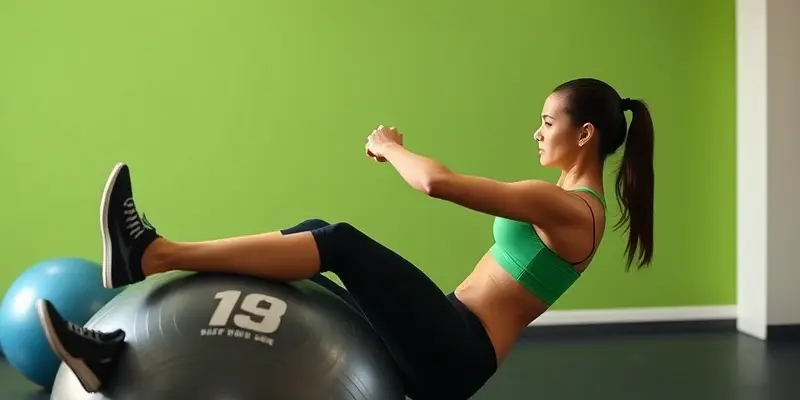Recovery is where your athletic journey truly evolves—whether you’re just starting out, a weekend warrior, or a seasoned competitor. With over a decade coaching athletes through setbacks and breakthroughs, I know that how you recover can make or break your progress. Today, let’s dive deep into how stability ball training can be your secret weapon for a faster comeback and a healthier, more resilient body.
What Is Stability Ball Training?
If you’ve seen that squishy, oversized ball at your gym and wondered if it’s just for stretching, think again! The stability ball (sometimes called a Swiss or exercise ball) is a dynamic tool. It challenges your body to stabilize itself, activating core, hip, and limb muscles in ways that traditional, static movements simply can’t. I use it with athletes of all ages and abilities to build foundational strength and support healthier movement patterns.
Imagine balancing on a floating dock versus standing on the ground—your stabilizer muscles switch on automatically. That’s the real-world benefit stability ball training imparts, making your joints and muscles more resilient to sporting demands.
Common Sports Injuries & How Stability Ball Training Helps
Sports injuries can happen to anyone—from beginners to pros. The most common culprits? Groin strains, hamstring pulls, lower back pain, and knee injuries. Here’s how the stability ball shines:
- Groin and Hip Injuries: Side planks with the ball build hip stability and strength, helping guard against painful strains.
- Hamstring & Back Issues: Ball hamstring curls and bridges target the back of your body (posterior chain), reducing strain and warding off tweaks.
- Knee Problems: Squats and bridges with the ball teach your joints to stay aligned, which is key to staying injury-free.
As both a coach and rehab specialist, I’ve seen athletes return to play faster and stronger when they use these tools, because the ball makes proper movement patterns nearly automatic.
Your Beginner-Friendly Stability Ball Recovery Plan
Getting started is simple. Here’s a sample session you can do 3x per week, in about 20–30 minutes. Focus on slow, controlled movements for safety and maximum benefit.
- Stability Ball Plank: 3 sets, hold for 20 seconds
- Glute Bridge (Feet on Ball): 3 sets of 12 reps
- Crunch on Ball: 3 sets of 15 reps
- Side Plank (Ball Between Ankles): 3 sets, 20 seconds per side
- Hamstring Curl (Feet on Ball): 3 sets of 12 reps
- Ball Squat: 3 sets of 15 reps
- Ball Pass (Leg to Hand): 3 sets of 10 reps
Progression Tips
Start with both feet on the floor if you’re a true beginner. As you gain control, try single-leg versions, add light resistance bands, or hold positions even longer. Challenge yourself, but listen to your body—proper form always comes first.
Nutrition for Recovery: Simple and Effective
What you eat powers your healing. I always recommend:
- Lean Proteins (chicken, fish, tofu): Essential for muscle repair.
- Complex Carbs (oats, quinoa): Restore energy so you heal quicker.
- Antioxidant-Rich Veggies (spinach, berries): Tame inflammation and promote recovery. For more on this, check out our guide on antioxidants in sports nutrition.
- Omega-3 Fats (salmon, walnuts): Soothe sore joints and reduce swelling.
- Hydration: Crucial to every step of the healing process.
A basic approach works—even for pros. Prioritize quality, whole foods over supplements unless specifically advised.
Recovery Tools That Actually Help
Beyond the stability ball, a few essentials maximize your routine:
- Foam Rollers & Massage Guns: Great for breaking up tight spots and improving blood flow.
- Resistance Bands: Add safe, progressive resistance without straining healing joints.
My clients often ask, “Isn’t fancy gear required?” Nope. The basics, used consistently, always win.
How to Stay Motivated During Rehab
I know recovery can feel endless. Here’s what works:
- Set Small Goals: Celebrate every tiny gain—your first pain-free plank, a deeper squat, improved balance.
- Train with Friends: Shared sweat leads to stronger resolve.
- Use Mindfulness: Focused breathing paired with exercise not only calms your mind, it speeds recovery by tuning in to your body’s needs.
Progress may not always be linear, but every step counts.
Key Takeaways & Encouragement
Stability ball recovery isn’t just rehab—it’s a long-term investment in your athletic future. With the right routine, smart nutrition, and a positive mindset, downtime from injury becomes opportunity. Recovery is not lost time; it’s where resilience is built.
If you have any questions about tailoring these routines or want support on your comeback journey, reach out or join the GymPulse Club community. Together, we’ll keep you strong, healthy, and thriving—every step of the way.

